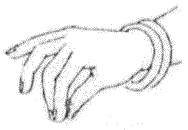Gestures, the movement of arms and hands, are different from other body language in that they tend to have a far greater association with speech and language. Whilst the rest of the body indicates more general emotional state, gestures can have specific linguistic content.
Gestures have three phases: preparation, stroke and retraction. The real message is in the stroke, whilst the preparation and retraction elements consist of moving the arms to and from the rest position, to and from the start and end of the stroke.
Emblems
Emblems are specific gestures with specific meaning that are consciously used and consciously understood. They are used as substitutes for words and are close to sign language than everyday body language.
For example, holding up the hand with all fingers closed in except the index and second finger, which are spread apart, can mean 'V for victory' or 'peace' (if the palm is away from the body) or a rather rude dismissal if the palm is towards the body.
Iconic gestures
Iconic gestures or illustrators are closely related to speech, illustrating what is being said, painting with the hands, for example when a person illustrates a physical item by using the hands to show how big or small it is. Iconic gestures are different from other gestures in that they are used to show physical, concrete items.
Iconic gestures are useful as they add detail to the mental image that the person is trying convey. They also show the first person or second person viewpoint that the person is taking.
The timing of iconic gestures in synchronization with speech can show you whether they are unconscious or are being deliberately added for conscious effect. In an unconscious usage, the preparation for the gesture will start before the words are said, whilst in conscious usage there is a small lag between words and gesture (which can make the speaker appear manipulative).
Metaphoric gestures
When using metaphoric gestures, a concept is being explained. Gestures are in three-dimensional space and are used to shape and idea being explained, either with specific shapes such as finger pinches and physical shaping, or more general waving of hands that symbolizes the complexity of what is being explained.
Regulators

Regulators are used to control turn-taking in conversation, for example in the way that as a person completes what they are saying, they may drop their arms, whilst a person wanting to speak may raise an arm as if to grasp the way forward.
Affect displays
Gestures can also be used to display emotion, from tightening of a fist to the many forms of self-touching and holding the self. Covering or rubbing eyes, ears or mouth can say 'I do not want to see/hear/say this'. Holding hands or the whole body can indicate anxiety as the person literally holds themself. Self-preening can show a desire to be liked and can indicate desire of another.
Beat gestures
Beat gestures are just that, rhythmic beating of a finger, hand or arm. They can be as short as a single beat or as long as needed to make a particular point.
Beating and repetition plays to primitive feelings of basic patterning, and can vary in sense according to the context. A beat is a staccato strike that creates emphasis and grabs attention. A short and single beat can mark an important point in a conversation, whilst repeated beats can hammer home a critical concept.
(http://www.changeminds.org/explanations/behaviors/body_language/gesture_type.htm)




1 comment:
Hyun,
As I mentioned to you already, I think this sounds great as a direction and the animations you create will be a useful reference for animators.
Arjun
Post a Comment